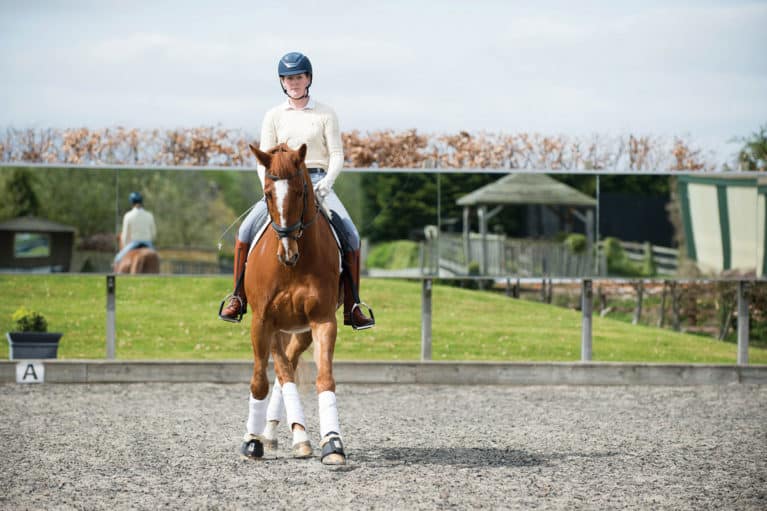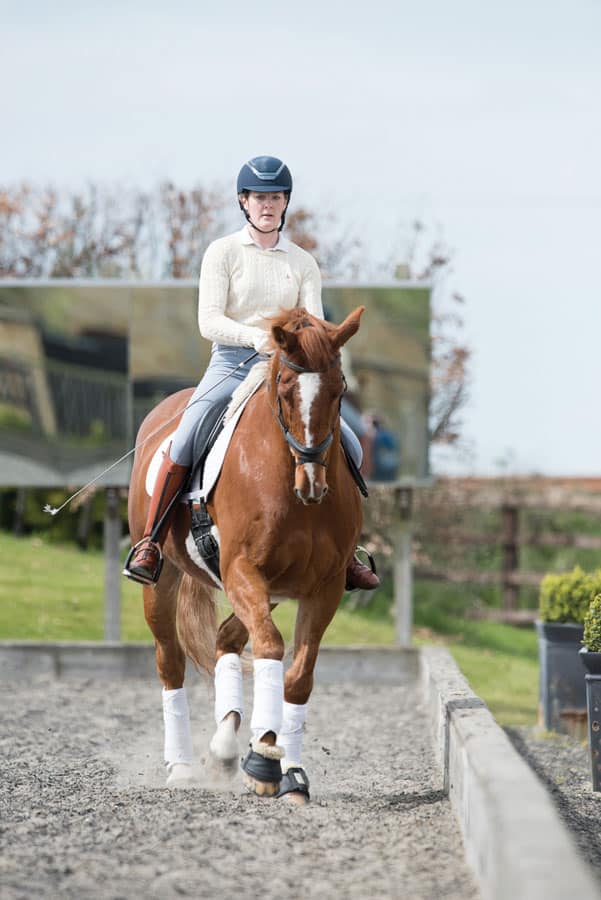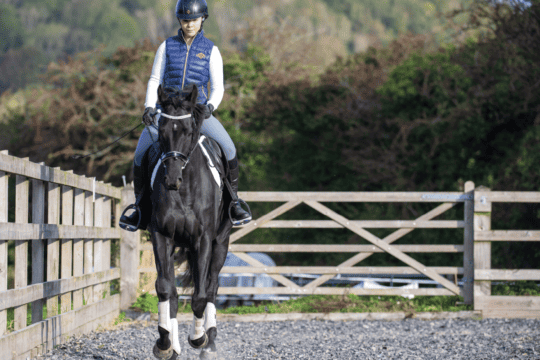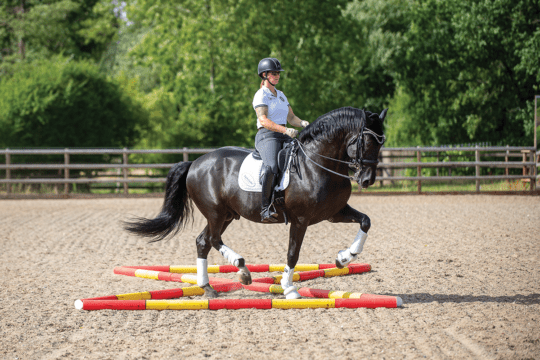Supple up your horse in no time with easy lateral work exercises from dressage rider Lucy Cartwright

A supple horse can move freely through his body and flow from one school movement to the next – it makes him a pleasure to ride. Suppleness is also important because without it he won’t be able to achieve self-carriage, impulsion or a true connection to your rein contact, meaning your schooling progress will be seriously limited. This is why making suppleness an everyday part of your horse’s training is important. A great way to do this is to introduce lateral work, which is like a gym workout for your horse.
While lateral work may sound daunting if you haven’t tried it before, don’t be put off – no matter what level you’re at, anyone can have a go. The key is to break your training down into bite-sized chunks and introduce it gradually so you both have time to get used to the different way of moving that lateral work asks for.
Top tip
You don’t need to be in an arena to practise lateral work – try it out hacking. Where it’s safe to do so, ask your horse to step across from one side of a path to the other, then back again. Leg-yield is a useful tool out hacking because it can help refocus your horse’s attention if he becomes distracted or spooks.
What’s lateral work?
Lateral work is all about asking your horse to move away from the pressure of your leg and step sideways as well as forwards down the arena. In some types of lateral work your horse travels across the arena, while in others you move his forehand or quarters off the track, but otherwise proceed in a straight line.
All lateral work requires your horse to bring his inside hindleg underneath his body, which means as well as being great for improving suppleness, it can help to improve his balance and self-carriage, too.
Top tip
While lateral work will improve suppleness, your horse does need a degree of flexibility to attempt it, which you can develop using basic school movements such as large circles, half circles and three-loop serpentines.
Perfect prep
Before you even think about having a go at lateral work, ensure you’ve both done a thorough warm-up, and your horse is relaxed and focused on you. He won’t be able to go sideways if he lacks impulsion in a straight line, so make sure he’s listening to your aids by riding lots of transitions.
Simple lateral work focuses on your horse moving away from your inside leg and to do this he must first be able to bend his body around it. So, begin your session by riding 20-metre circles, three-loop serpentines and shallow loops, focusing on establishing correct bend and ensuring he’s listening to you and moving freely. If all feels correct, you’re ready to begin going sideways.
Did you know?
Every horse finds it easier to bend in one direction. While you want to work him evenly in order to improve this one-sidedness, only focus on his weaker rein in short bursts. This will help supple him up gradually. If you spend too much time on his less-supple side, it’ll be really hard work for him and can make his muscles sore.
Exercise: Leg-yield
Leg-yield is the ideal introduction to lateral work. It teaches your horse to move away from your leg and take one sideways step for each forward one. The aim is for your horse to bring his inside hindleg underneath his body, crossing it in front of his outside hindleg and pushing himself sideways. Start in walk to give you a chance to perfect your aids and give your horse time to understand what’s being asked of him…
- Ensure he’s marching forward in walk, then turn off the track onto the three-quarter line
- Ride straight for a few steps, focusing on maintaining the same rhythm
- Flex his head slightly to the inside, but keep his body straight by supporting his quarters with your outside leg on the girth
- Use your outside rein to support his shoulder and keep his body straight
- Nudge with your inside leg just behind the girth to ask him to step across
- Take your leg off to allow him to go forwards, then apply it again to ask for another sideways step
- Repeat, focusing on maintaining impulsion using your outside leg
- After a few crossing steps, ride forward out of the leg-yield and give him a pat
Important!
When you’re introducing lateral work, remember to ask for just a few steps at a time and don’t spend too long practising in each session. Break things up by riding other school movements to keep him thinking forwards.
Top tip
If you’re not sure your horse is actually crossing his inside leg underneath his body, ask a knowledgeable friend to watch you ride or, if you have them, ride towards arena mirrors so you can see what his legs are doing. You can also ask someone to video you.
Textbook technique
While true leg-yield involves your horse crossing his inside hindleg in front of his outside hindleg, it may take a few sessions before he understands exactly what’s expected and for him to develop the suppleness to allow this. So don’t worry too much if he doesn’t achieve clear crossing of his legs to begin with.
Problem solver
The fault Your horse falls out through his shoulder and drifts across the school
The fix It’s leg-yield, not rein-yield, so resist the temptation to create bend by pulling on your inside rein. Make sure you’re not asking for too much inside flexion and focus on keeping him straight in his body by maintaining a steady contact through your outside rein. Try riding one step of leg-yield, then asking him to travel forward in a straight line until you’re confident you’re in control of his outside shoulder, before asking for another step sideways
The fault He runs out of energy
The fix Use your outside leg to keep him moving forward. It’s easy to focus on your inside leg and asking him to step across, then forget to use your outside leg, which is the most common cause of a lack of impulsion. Don’t be afraid to back up your aid with a tap from a schooling whip to ensure he understands what you want
Top tip
If your horse is losing motivation, ask yourself whether you’re over-riding the exercise. Remember that it’s physically and mentally demanding for him, especially at the beginning. Don’t expect too much too soon and use frequent breaks to reward him.
The fault His quarters overtake his shoulders
The fix When you turn down the three-quarter line, ensure you ride forward completely straight for a few strides then, as you ask for leg-yield, maintain your outside leg against his side, behind the girth, to prevent his quarters drifting
Up the challenge
When you’ve both got the idea, you can have lots of fun with leg-yield. Try these variations….
- leg-yield from the centre line to the track
- on a 20-metre circle, spiral down to a 10-metre circle and back out again, which uses the same aids as leg-yield
- ride a zigzag from the centre line – leg-yield to the left for a few steps, ride straight for a few steps, then leg-yield to the right and repeat down the arena
- up the pace to trot – things will happen a lot faster, but don’t allow your accuracy to slip. If your horse begins to rush or fall out, straighten him up, ride a half-halt to rebalance him and try again. If it’s still not clicking, return to walk to re-establish the aids and try again
- have a go at leg-yield in canter
Exercise: Quarters-in
When you’ve got leg-yield sussed, you can try other lateral moves such as travers (quarters-in). This exercise encourages your horse to stretch through his ribcage and engage that all-important inside hindleg. As the name suggests, your horse’s quarters move off the track, but his forelegs stay on the track. While performing travers, his outside hindleg and foreleg will be moving forwards and across under his body.

Even if he’s got the hang of leg-yield, remember you’re teaching him something new, so keep things easy and stay in walk until he gets the idea…
- Turn down the long side and ride straight for a few steps, then apply your outside leg behind the girth to push his hindquarters over
- Maintain your inside leg on the girth to keep his forehand on the track and encourage inside bend
- Ask for a little inside flexion
- Use your outside rein to support his outside shoulder and control the amount of bend, keeping him looking ahead in the direction he’s travelling
- Keep your own shoulders parallel to your horse’s shoulders
- After a few lateral steps, go straight
Problem solver
The fault Your horse is reluctant to bring his quarters over
The fix Check that you don’t have too much neck bend and try again with a straighter neck. It’ll be hard to bring his quarters in if he lacks suppleness, so ride lots of circles, loops and serpentines to help improve this
The fault His quarters come in too much
The fix Create more bend with your inside leg and don’t apply so much pressure with your outside leg so he stays straighter
Up the challenge
It’s easiest to teach travers down the long side of the arena, where you’ve got the fence to support you, but you can also ride the movement…
- down the three-quarter line
- on a circle
- across the long diagonal – this is the first step towards teaching your horse half-pass
Reap the rewards
By introducing these lateral work exercises into your horse’s regular schooling routine, you’ll soon see a difference in his suppleness, whatever discipline you both enjoy. As well as finding flatwork easier, it’ll improve his jumping by helping him make balanced turns between fences and engage his hindquarters more efficiently.








